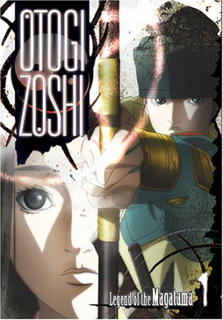 What do you get when you cross Disney's Mulan with a Feng Shui class? Otogi Zoshi.
What do you get when you cross Disney's Mulan with a Feng Shui class? Otogi Zoshi. Survey: Because this story very definitely takes place in two separate eras (more on that below), you really must review it as two separate stories:
Vol 1 - III
Young Lady Hikaru Minamoto takes up the quest of her terminally ill brother Reiko to retrieve the lost pieces of the fragmented mystical Magatama in order to bring healing back to the capital city of Heian-Kyo (the ruling center of the Heian Empire during Japan's Feudal Era). A master archer and formidible warrior herself, dressed as her brother, and aided by her friends Tsuna, Sadimitsu, Yurabe and Kintaro, she travels to the distant reaches of the empire to engage animal-like ninja (the Tsuchigumo's), pirates, Scandanavian Viking-Samurai (weird, i know), and the traitorous Onmyogi (Daoist priests who are secretly trying to overthrow the empire). Largely succeeding only through the sacrifice and determination of her friends, and her own unconquerable faith in her conviction that she is doing what is right, Hikaru is eventually forced to decide between personal love and corporate sacrifice to save not only the Empire, but the world.
Vol IV
Hikaru, Tsuna, Sadimitsu and Kintaro are all reincarnated into 2005 Tokyo teen personalities, which is kind of a cool concept, except that the story takes a massive dive south from there. In almost a bizarre Scooby-Doo fashion, the group sets out to explore the "mysterious phantom train" that haunts the tracks of the Tokyo subway line late at night, as well as understand the supernatural forces which are attempting to destroy the entire city by manipulating the Daoist forces of nature (Wind, Water, Fire, Earth) in a sort of Feng-Shui H-Bomb. I tuned in and out through the final couple of episodes as even the "track record" of the characters (which you already like and enjoy from the first 3 volumes) isn't enough to hold one's attention, until the final "climax" of the story in which Hikaru has a strange out of body reconciliation with her Heian self and somehow saves the city.
Thumbs Up:
The series is set actually fairly well in a historical period called the Heian Era (794 - 1185 AD) in Japan. During this time, there was a lot of weirdness that reigned in the country, and it was only loosely held together by an overly corrupt political system that depended heavily upon its bureacracy rather than its capability. Such is fertile ground for the series, which itself is actually based on a supposedly true legend about a young noblewoman who took the guise of her secretly dead brother to save Japan and reunite the empire.
The series also has some fun twists, some deceptive characters (you think they're bad... but they're not. Or you think that they're good... but they're not), some great animation, and some fantastic fight sequences.
Thumbs Down:
The series has a WAY dorky ending, so basically, watch the first 3 volumes... they're fun. Skip the last. It stinks.
Overall Rating (1 to 5 stars): ***

1 comment:
Precious!
Post a Comment